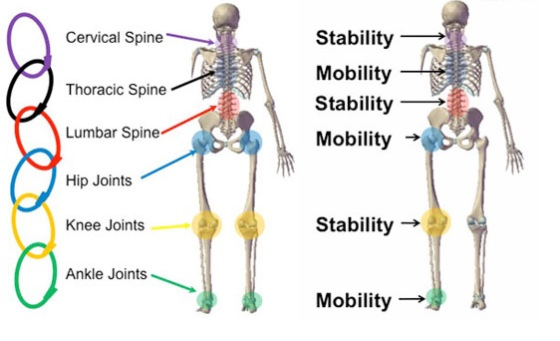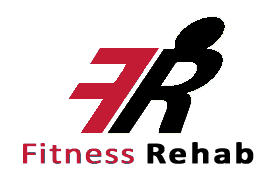
Knee pain is something I see a lot in clients ranging from soccer players to people just like your parents. Their doctor usually tells them that they have tendonititis, arthritis, patellar femoral syndrome, jumpers knee or another diagnosis that they likely do not fully understand.
While there are many reasons why a knee becomes painful, allow me to translate all of the above: overuse of a certain area and under the use of others. Our body is a system of joints in which some operate as springs to absorb shock (mobile joints) and others operate as anchors to bear weight (stable joints). When the springs fail to do their job due to stiffness or weakness, the anchors often bear more weight which is often the case with the knee (an anchor).

A big take away here is that the same could be said of any joint in the body. If you have pain in the back, for example, do your hips (which are designed to be springy and move more) have full ROM? I am including an illustration that really hammers home this point. In this article, I want to briefly cover three of the most important joints that affect the knee and how to address them to begin getting some relief. Tibial rotation: The tibial is our lower leg bone between our foot and knee. In order to lock the knee out, it must internally rotate as if turning a screw.
If this doesn’t happen, the knee stays slightly flexed all the time. Where you will most likely feel this is a pain in the back of the knee. If this is the case, try this sequence.
Ankle dorsiflexion:
Do you ever have tight calves? If you wear heels (burn baby burn), sit for a living or even have a slouchy posture, chances are a lack of ankle dorsiflexion or the ability to push the toe over the knees with the heel flat could be affecting your knees. I have gone into length in past articles about how a forward center of gravity in which we put our weight on our toes versus our heels can lead to this issue, but the bottom line is that restoring this quality will greatly enhance the knees. Do so with this sequence.
Hip rotation:
For those with pain on the inside or outside of their knee, a lack of hip muscle control can lead to the knee the following suit. If I am experiencing outer knee pain, I likely have issues with hip internal rotation whereas the opposite is true if the pain exists on the inside. In either scenario, here is a sequence to address both.
Conclusion/disclaimer:
I am not a doctor and I am not diagnosing your knee pain. What I do hope to do with this article is to provide some common sense answers and tools that may allow for some relief. Use them at your own risk and give me a holla if they help you!
Sincerely,




